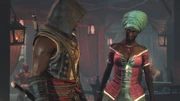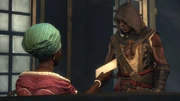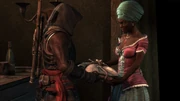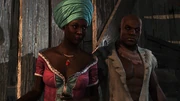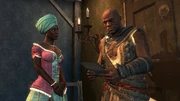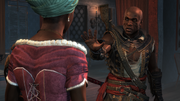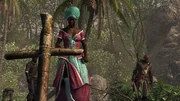Bastienne Josèphe (1690s – before 1776) was the madam of La Dame en Rose, a brothel in Port-au-Prince, during the 1730s, and a supporter of Augustin Dieufort's Maroon rebellion. She was the mother of Babatunde Josèphe, grandmother of Eseosa, and is an ancestor to Milton Jones.
Biography[]
Early life[]
Born to a prostitute at La Dame en Rose, Bastienne grew up in the brothel she would later own. When she was young, she allowed outside children to spy on the brothel's illicit activities for a price. Entering her teens, her training in reading, writing, and financial management made her an indispensable assistant to the brothel's madam. During this time, she came to understand that the business could be used for great political gain, as deal-making, scandals, and exchanges of information were common at the brothel.[1]
Though Bastienne was at one point engaged, she ultimately forewent marriage to inherit La Dame en Rose when the previous madam passed. Her skill with finances allowed her to double the business' profits, a portion of which she used to buy the freedom of slaves in Port-au-Prince. She then began acting as an informant for the Maroon rebellion, using her courtesans to gather information on their politically powerful clients.[1]
At some point during her time as madame, Bastienne became acquainted with the Templar Order, working for them as a courier of sorts, and using the money they gave her to free slaves. She also became an informant for the Maroon rebellion led by Augustin Dieufort, and maintained a friendship with Pierre, Marquis de Fayet, the French governor of Saint-Domingue, which was just a ruse to acquire more information to further the Maroon cause.[2]
Working with Adéwalé[]
In 1735, Bastienne met Adéwalé, an Assassin who had been shipwrecked on Saint-Domingue following the loss of his brig, the Victoire. Adéwalé had intercepted a Templar parcel being delivered to her and refused to hand it over until Bastienne proved she was trustworthy. Bastienne soon convinced the Assassin to aid the growing Maroon resistance and, though their relationship was initially rocky, they grew close over the following years.[3]

Bastienne and Adéwalé in La Dame en Rose
When de Fayet became inexplicably strict in his enforcement of the Code Noir, Bastienne tasked Adéwalé to infiltrate the governor's mansion by posing as a slave in order to spy on him. Adéwalé learned that de Fayet was sponsoring an expedition headed by a scientist named Louis Godin, which concerned Bastienne, as none of her informants had told her of such an expedition.[4]
Following further investigations, Adéwalé discovered that the expedition's intended goal was to map the circumference of the Earth, so as to provide the French with accurate geographical knowledge far surpassing that of its national rivals. While this intrigued the Assassin, who believed that the knowledge gained from the expedition would greatly benefit his Order, Bastienne was not impressed by how little Adéwalé had learned and dismissed him.[5]
Eventually, Bastienne's anger subsided and, in order to help the Maroons and fulfill her promise to Augustin, she came up with a plan to replace the expedition's illiterate slaves with literate ones that could then pass the information to the Maroons. She gave Adéwalé a forged manifest listing the literate slaves' names, which the Assassin procedeed to swap with the real one, ensuring the right people joined the expedition.[6]
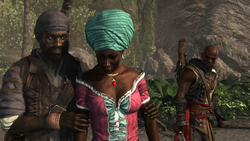
Augustin consoling Bastienne
By 1737, the French had grown concerned over the increasingly strong Maroon resistance and the number of slaves being liberated by Adéwalé. In response, they began to impose stricter curfews, as well as harsher and more frequent punishments. Bastienne tried to dissuade Adéwalé from continuing his attacks against the French, but he angrily dismissed her.[7]
However, they both soon witnessed de Fayet's cruelty when a French vessel, acting under the governor's orders, opened fire on a slave ship which had been disabled by Adéwalé, to prevent the slaves from escaping. Although Adéwalé managed to rescue some of the slaves, most drowned and were subsequently buried by Bastienne, Adéwalé and Augustin. While Bastienne mourned their loss and was appalled by the extent of de Fayet's heartlessness, Adéwalé set out to kill the governor, claiming his Creed demanded it.[7]

Bastienne and Adéwalé bidding each other goodbye
After Adéwalé assassinated de Fayet, he was forced to leave Port-au-Prince, since remaining would call both his and the Maroons' safety into question. Before leaving, he visited Bastienne one last time to say goodbye and give her the contents of the Templar parcel: a Precursor box. As Bastienne had no one left to sell it to anymore, she elected to keep the box as a memento.[8]
Later life[]
At some point after de Fayet's death in 1737, Bastienne and Adéwalé shared a night of passion, leading to the eventual birth of a son, Babatunde. Adéwalé met Babatunde in 1751 while visiting Port-au-Prince to offer aid following an earthquake, and recruited him to the Assassins. Babatunde would later father Eseosa, who also joined the Assassins and eventually became an influential participant of the Haitian Revolution.[9]
By November 1751, Bastienne's Precursor box was in the possession of François Mackandal, the Mentor of the Saint-Domingue Brotherhood of Assassins. It would subsequently be stolen, alongside the Voynich manuscript, by the Master Templar Lawrence Washington, who took both artifacts to the British colonies in America.[10]
Bastienne passed away at some point before 1776.[9]
Trivia[]
- Bastienne's character is based on the historical figure of the same name, a free business woman of color who ran a brothel in French-occupied Saint-Domingue during the 18th century.[11]
Gallery[]
Appearances[]
- Assassin's Creed IV: Black Flag – Freedom Cry (first appearance)
- Assassin's Creed: Initiates (mentioned only)
- Assassin's Creed: Rogue (indirect mention only)
References[]
- ↑ 1.0 1.1 Assassin's Creed IV: Black Flag – Freedom Cry – Database: Bastienne Josèphe
- ↑ Assassin's Creed IV: Black Flag – Freedom Cry
- ↑ Assassin's Creed IV: Black Flag - Freedom Cry - A Common Enemy
- ↑ Assassin's Creed IV: Black Flag - Freedom Cry - Lifting the Veil
- ↑ Assassin's Creed IV: Black Flag - Freedom Cry - A Scientific Inquiry
- ↑ Assassin's Creed IV: Black Flag - Freedom Cry - Plant the Seeds
- ↑ 7.0 7.1 Assassin's Creed IV: Black Flag - Freedom Cry - Down with the Ship
- ↑ Assassin's Creed IV: Black Flag - Freedom Cry - De Fayet's Last Stand
- ↑ 9.0 9.1 Assassin's Creed: Initiates – Letters to the Dead
- ↑ Assassin's Creed: Rogue
- ↑ The Mary Sue | Game Changer: Writer and Narrative Designer Jill Murray Talks Making Personal Games, the Importance of Communication and Researching Coffee
| |||||||||||||||||||||||||||||||

